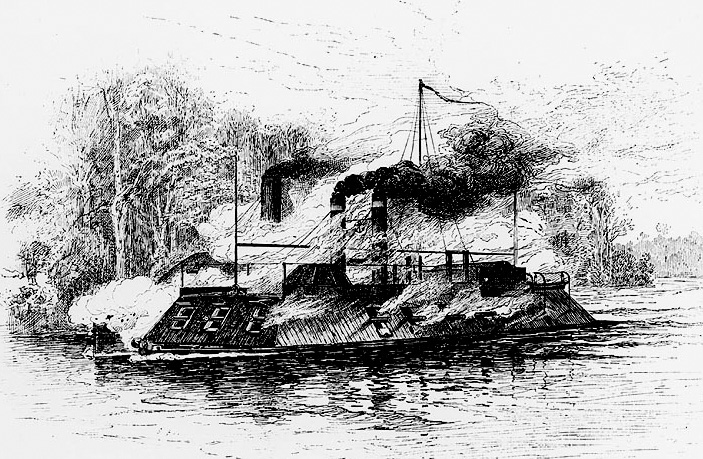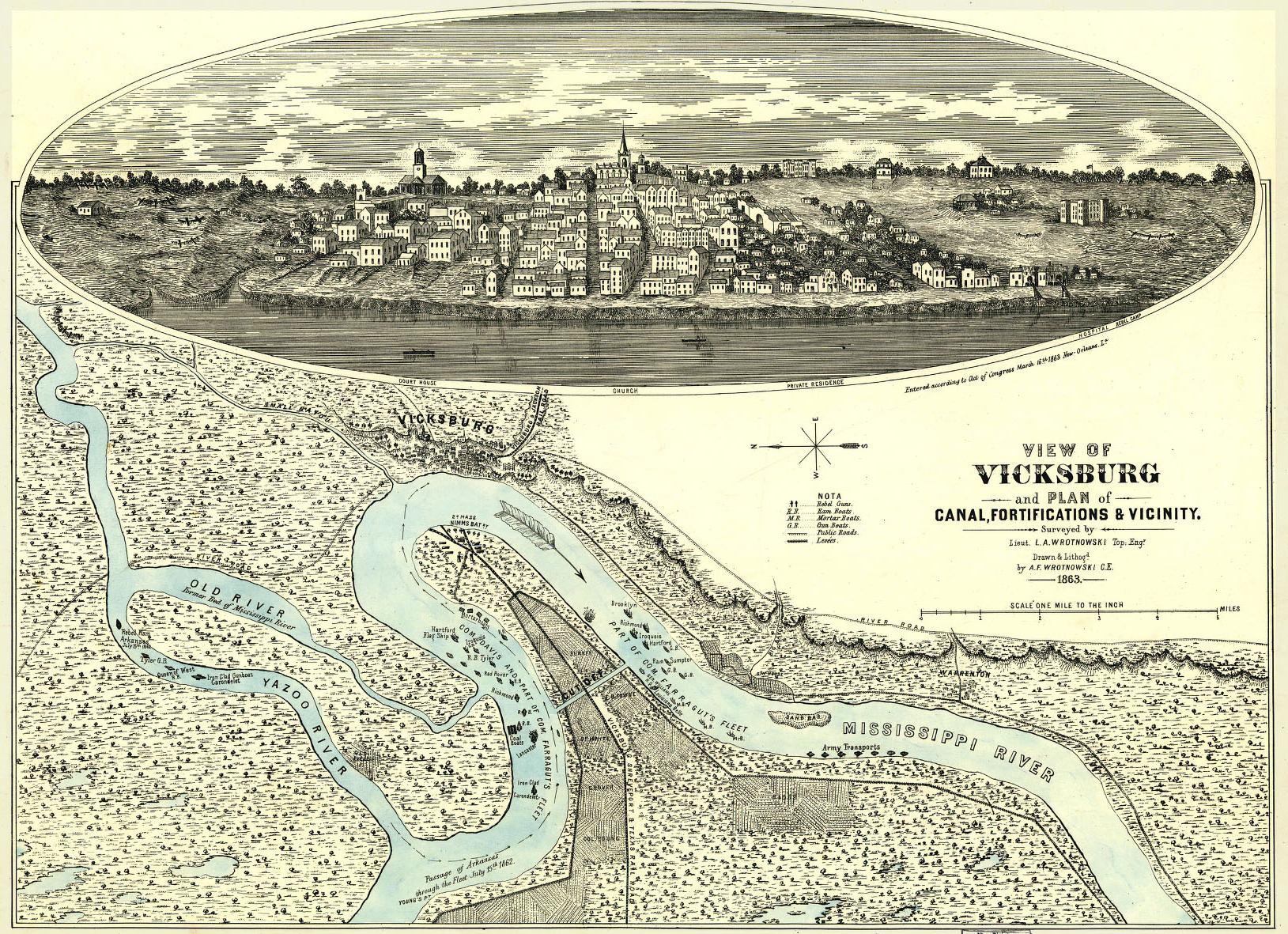Down the Yazoo with the Ironclad CSS Arkansas

Running downriver with the surging Mississippi in the CSS Arkansas on July 15, 1862, Captain Isaac N. Brown peered through the morning mist and saw: “A forest of masts and smoke-stacks—ships, rams, iron-clads, and other gun-boats on the left side, and ordinary river steamers and bomb-vessels along the right.”[i]
His battered ship and crew confronted a gauntlet of enemy men-of-war mounting hundreds of guns lining the eight-mile path to refuge under the heavily fortified cliffs of Vicksburg. How did he get in this fix?
Flag Officer David G. Farragut’s squadron had ascended from the Gulf of Mexico after taking New Orleans while a flotilla of U.S. Army gunboats and rams under Flag Officer Charles H. Davis descended the river from its junction with the Ohio, neutralizing Rebel river forces above the city.
They met in the middle with a mission to bombard this “Gibraltar of the Confederacy” into submission and regain control of the continental artery for the Union. Soon thereafter, General Earl Van Dorn, commanding Confederate forces at Vicksburg, ordered Brown to bring the ship down from his base up the adjoining Yazoo River.
Yankees ahead were not Brown’s only problem. The former U.S. Navy lieutenant and Mexican War veteran had been given command of a woefully incomplete Arkansas on May 28. “Her condition was not encouraging. The vessel was a mere hull, without armor; the engines were apart; guns without carriages were lying about the deck; a portion of the railroad iron intended as armor was at the bottom of the river….”
Construction of Arkansas began in October 1861 upriver at Memphis, Tennessee, but upon approach of the Federal fleet, she was hastily towed down the Mississippi and up the Yazoo. Her sister ship, CSS Tennessee, was burned on the stocks to prevent capture.

The new captain worked a near miracle on the river bank—finishing, armoring, arming, and equipping Arkansas within five weeks with no shelter under the Delta summer sun and under “the depressing thought” that they were but six hours’ steaming from a Federal fleet whose guns were within hearing.
Two hundred army workers labored; fourteen blacksmith forges requisitioned from nearby plantations blazed; extemporized drilling-machines roared. More than a hundred sailors from other Mississippi vessels plus around sixty Missouri volunteer soldiers filled out the crew of 232 officers and men.
The precise dimensions of the vessel are uncertain; there are no known photographs or plans and only two rough contemporary sketches. According to Brown: “The Arkansas now appeared as if a small seagoing vessel had been cut down to the water’s edge at both ends, leaving a box for guns amidships.”
She was 165 feet long, 35 feet wide, displacing approximately 800 tons with a draft of 11.5 feet. The casemate reportedly sandwiched some twenty inches of compressed cotton bales between two six-inch oak layers, to be covered with another six-inch layer of railway iron; the sides were vertical, the ends sloped at thirty-five degrees. “These ends deflected overhead all missiles striking at short range, but would have been of little security under a plunging fire.” The flat top was covered with plank and half-inch iron, pierced by a huge smokestack and two hatches with ladders to the gundeck below.
Arkansas mounted ten guns, probably two 8-inch 64-pounder Columbiads forward, with two 9-inch Dahlgren shell guns, two 6-inch Brooke rifles (or 6.4-inch rifled 32 pounders), and two 32-pound smoothbores in broadside, and another two 6-inch rifles astern. “The battery was respectable for that period of the war,” noted Brown. Some combination of bad paint and rust turned her a dark or chocolate brown. Flag Officer Davis would observe that Arkansas was “an ugly customer.”[ii]
But the ironclad was not finished. They lacked equipment to bend railway iron to the curve of the ship’s quarter and stern, and to the angles of the pilothouse, “though there was little thought of showing [the stern], the weakest part, to the enemy,” recorded Brown. Two-inch boilerplate iron was tacked in place for appearance sake; the pilothouse, which rose about a foot above the front of the casemate, was imperfectly shielded with a double layer of one-inch bar iron.
The engine was unreliable. Twin propellers drove the vessel up to eight miles an hour in still water and about half that against the main current. But one or the other of the screws would demonstrate a dismaying tendency to stop, causing the vessel to turn despite the rudder until they could get it started again.
Coming within months of the famous first contest between ironclads CSS Virginia and USS Monitor, many Northerners feared and Southerners celebrated the new river ironclad as a potential super-weapon—a sort of “ram fever.” Farragut and Davis suspected Arkansas would appear soon.
A Union squadron consisting of the river ironclad Carondelet, the wooden gunboat (“timberclad”) Tyler, and the ram Queen of the West was dispatched upriver on reconnaissance just as Brown was coming down. They met head to head as the sun rose through morning haze above the hills.
The Union ships turned and ran for their fleet with Arkansas pursuing, initiating a running battle. “The stern guns of the Carondelet and the Tyler were briskly served on us,” recalled Brown. He stood on top of the casemate directly over the bow guns watching his shot all the way to where it struck Carondelet while return missiles slammed the inclined armor at his feet, blowing shell fragments and big iron splinters over his head. “I received a severe contusion on the head, but this gave me no concern after I had failed to find any brains mixed with the handful of clotted blood which I drew from the wound and examined.”
A moment later, shot from Tyler penetrated the pilot-house and blew off a section of the wheel, mortally wounding Chief Pilot Hodges and disabling the Yazoo River pilot. “James Brady, a Missourian of nerve and equal to the duty, took the wheel, and I ordered him to ‘keep the iron-clad ahead.’”
Another round passed down the side without hitting Arkansas but decapitating a young Irish volunteer who had imprudently stuck his head out the gun port to see what has going on. The headless corpse was tossed out the port. One of the Arkansas propellers stopped; she made a full circle before it started again.
As the faster Rebel ironclad closed the gap, Yankee sharpshooters on Tylor released a hail of fire pinging off the iron. Still on top of the casemate, Brown headed for the hatch when a Minnie ball creased his left temple. He tumbled down the ladder to the gundeck, knocked briefly unconscious, but recovered with only scrapes and bruises and climbed back up the ladder to his post.

Carondelet absorbed repeated hits in her lightly protected stern with widespread damage and multiple casualties. She was finally disabled with a shot through the steering mechanism, causing her to run aground.
Brown ordered hard port rudder, ranged alongside Carondelet, depressed his guns, and delivered a broadside that rolled her violently over and back, sloshing water across the deck. “Our crew, thinking her sinking, gave three hearty cheers.” Then Brown turned his ship, exposing the vulnerable stern, and let loose more shots from the rear guns. “Their ports were closed, no flag was flying, not a man or officer was in view, not a sound or shot was heard.”
The second contest between ironclads was over with a clear winner this time. (Carondelet would recover and participate in most subsequent river campaigns.) It was a fair hour’s work, wrote Brown, “but knowing what was ahead of us, we had to regard it in the same light as our Missouri militia did, as ‘a pretty smart skirmish.’” Arkansas continued down the Yazoo and into the Mississippi in pursuit of Tyler and Queen of the West.
Brown took the opportunity to inspect conditions below. Enemy shrapnel and Minnie balls riddled the stack and opened gaps in joints with the boilers, destroying the draught, blowing heat, flame, and smoke about, raising temperatures to 120° on the gundeck and 130° in the fire room.
Boiler fires were starved of air and men were breaking down. First Lieutenant Henry Stevens (“a religious soldier, of the Stonewall Jackson type, who felt equally safe at all times and places,” wrote Brown) rotated gun crews down into the boiler and engine spaces every fifteen minutes. Those emerging were hauled up exhausted.
They went into action with 120 pounds of steam, but despite every effort, were down to 20 pounds, hardly enough to turn the engines. Brown had hoped to apply his ram to the hull of Yankee vessels, but had neither the speed nor confidence in the engines to do so.

Pushed by the Mississippi current, Arkansas closed on the Federal fleet. “It seemed at a glance as if a whole navy had come to keep me away from the heroic city,” wrote Captain Brown. Will they make it through to Vicksburg? Stay tuned.
[i] Isaac N. Brown, “The Confederate Gun-Boat ‘Arkansas’,” in Battles and Leaders of the Civil War, Being for The Most Part Contributions by Union and Confederate Officers. Based Upon “The Century War Series.” Edited by Robert Underwood Johnson and Clarence Clough Buel, of the Editorial Staff of “The Century Magazine”, 4 vols. (New York, 1884-1888), vol. 3, 572-575. Ibid. for all Brown quotes in this article.
[ii] Myron J. Smith, Jr., The CSS Arkansas: A Confederate Ironclad on Western Waters (Jefferson, North Carolina, 211), 100.
Interesting read; it is amazing how much effort was expended by the Confederates to build the ship and the incredible sacrifices of her crew. The folly of war writ large.